Snapdragon 800 (MSM8974) Performance Preview: Qualcomm Mobile Development Tablet Tested
by Brian Klug on June 18, 2013 8:00 PM EST3DMark
3DMark for Android features the Ice Storm benchmark and uses OpenGL ES 2.0. Ice Storm is divided into two graphics tests and a physics test. The first graphics test is geometry heavy while the second test is more pixel shader intensive. The physics test, as you might guess, is CPU bound and multithreaded. The overall score takes into account both graphics and physics tests. The benchmark is rendered to an offscreen buffer at 720p/1080p and then scaled up to the native resolution of the device being tested. This is a very similar approach we've seen by game developers to avoid rendering at native resolution on some of the ultra high resolution tablets. The beauty of 3DMark's approach here is the fact that all results are comparable, regardless of a device's native resolution. The downside is we don't get a good idea of how some of the ultra high resolution tablets would behave with these workloads running at their native (> 1080p) resolutions.
For these benchmarks we stuck with the default presets (720p, normal quality).
Here the key comparisons are against the Adreno 320 based HTC One/SGS4 (T-Mobile) and the PowerVR SGX 544MP3 based SGS4 (SHEVE300S). The Nexus 10 is interesting but pretty much a blowout. Snapdragon 800 is clearly the new high-end Android tablet SoC of choice.
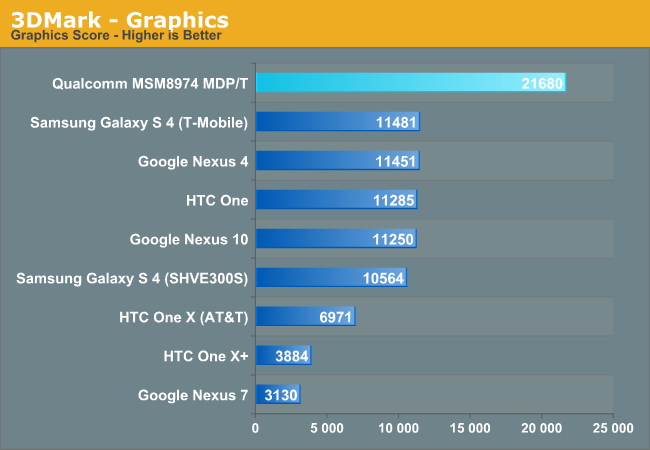
The overall graphics score from Adreno is amazing. We're looking at almost 2x the next fastest contender here, the Adreno 320 based Snapdragon 600.
Graphics Test 1
Ice Storm Graphics test 1 stresses the hardware’s ability to process lots of vertices while keeping the pixel load relatively light. Hardware on this level may have dedicated capacity for separate vertex and pixel processing. Stressing both capacities individually reveals the hardware’s limitations in both aspects.
In an average frame, 530,000 vertices are processed leading to 180,000 triangles rasterized either to the shadow map or to the screen. At the same time, 4.7 million pixels are processed per frame.
Pixel load is kept low by excluding expensive post processing steps, and by not rendering particle effects.

Graphics Test 2
Graphics test 2 stresses the hardware’s ability to process lots of pixels. It tests the ability to read textures, do per pixel computations and write to render targets.
On average, 12.6 million pixels are processed per frame. The additional pixel processing compared to Graphics test 1 comes from including particles and post processing effects such as bloom, streaks and motion blur.
In each frame, an average 75,000 vertices are processed. This number is considerably lower than in Graphics test 1 because shadows are not drawn and the processed geometry has a lower number of polygons.
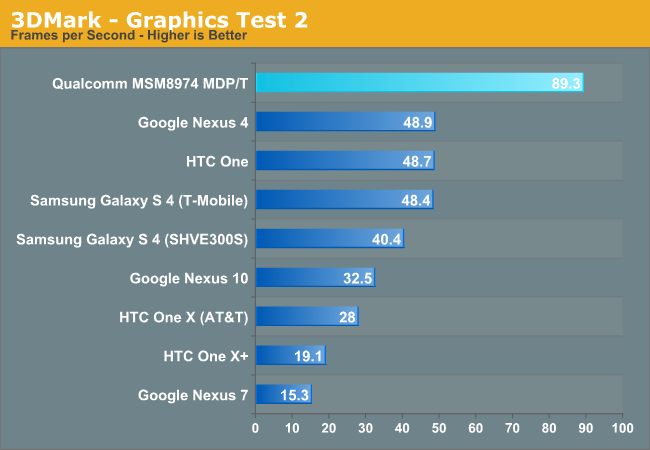
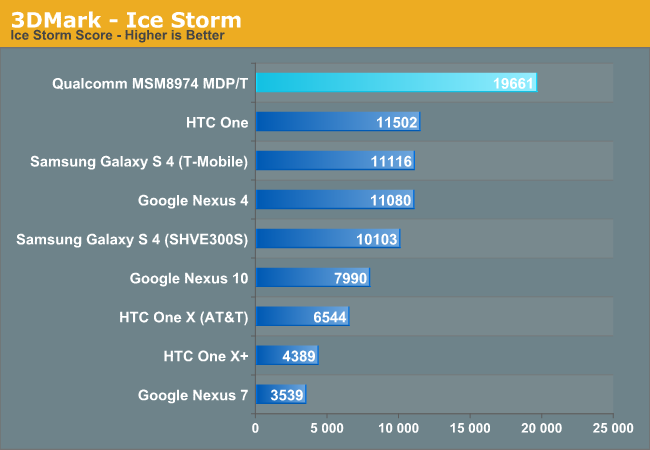
The overall Ice Storm score shows a 71% improvement over Snapdragon 600, which is the closest competitor.
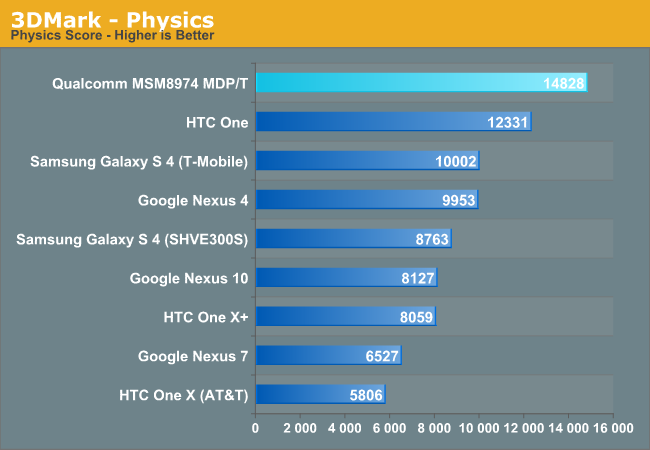
The physics test takes multicore CPU performance into account, but even then the Snapdragon 800 remains ahead of the pack. The performance advantage over the lower clocked Snapdragon 600 shrinks to just 20%, which is a bit lower than clock speeds alone would normally tell us.
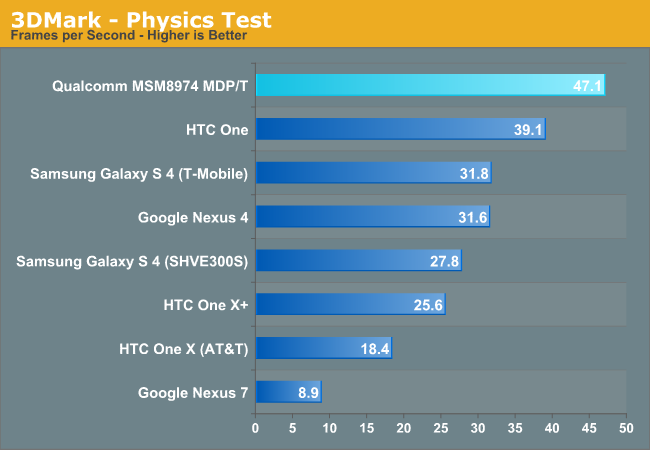










115 Comments
View All Comments
althaz - Tuesday, June 18, 2013 - link
*Their*I'm not sure you could call them the Intel of Mobile. There's a couple of key differences - the first and most obvious being that Intel is leading in x86 IPC, power management and, this is the big difference, manufacturing. Intel won't and can't go away because they have a tangible advantage over their competitors that will require incredible investment to overcome.
The other is that Qualcomm have a large slice of an ever-increasing pie, but Intel have basically the whole x86 cake to themselves, with the crumbs falling to AMD.
It's probably also worth mentioning that Qualcomm seem better at producing the right improvements for consumers, wheras Intel were late to the low-power party and slow to get going on graphics to (although both are clear foci of the company now).
Interestingly, I believe Qualcomm's mobile division is basically AMD/ATI's old mobile division, which they didn't think was worth it to keep. That's looking a like a pretty huge mistake right now.
tuxRoller - Wednesday, June 19, 2013 - link
Thanks for the grammar correction, teach. Now that I know it any way you can teach it to my phones keyboard? Grammar is useful for helping to avoid ambiguity but the previous could only be understood one way. IOW, your correction wasn't needed unless you were just being anal.You make some good points and it's clear that not clear what it means when someone says "X is the Intel of Y". Intel using their fab is certainly a part of their success. That they are THE key x86 player is, I think, the more important touchstone. It was that which I was speaking of when I spoke of them. I THINK they are, by far, the biggest, most profitable supplier of ARM based SoC in the world. Samsung is huge but they consume what they make. TI is leaving the mobile field and haven't had a major design win for awhile.
BTW you're right about ATI and adreno but the 300+ series is vastly different from the architectures Qualcomm inherited from ATI.
FwFred - Tuesday, June 18, 2013 - link
Very inconclusive without any power measurements. In its tablet reference form factor certainly beats modern SoCs in phone form factors. I'd like to see it against Tegra 4, Bay Trail, and Haswell (4.5W SDP) in a tablet form factor.grahaman27 - Tuesday, June 18, 2013 - link
I second that.aryonoco - Wednesday, June 19, 2013 - link
I agree, I want to see it next to Tegra 4, Bay Trail, and also Kabini and Temash.But I have to say, it looks good, really good. Especially that GPU.
To think that Adreno was AMD/ATI's embedded graphics division that AMD didn't think was worth anything and sold for peanuts (something like $30M IIRC) to Qualcomm. Dirk Meyer really ruined that company.
FwFred - Wednesday, June 19, 2013 - link
Doh, totally forgot about Temash. I was trying to think of all the fanless tablet SoCs coming out.wsw1982 - Thursday, June 20, 2013 - link
The engadget has the benchmark for snapdragon on phone and tablet. It can be seen that the snapdragon 800 is very fast in tablet setup, but only little bit faster than snapdragon 600 in phone setup. I guess this partly answered your TDP concern.http://www.engadget.com/2013/06/18/qualcomm-snapdr...
iwod - Tuesday, June 18, 2013 - link
I Love the Equalizer Part. Finally we have some sense of how far we are from Mainstream Desktop Performance. Would be great if Haswell were added to the Chart, and a UL Haswell running at similar Power usage in there as well. ( Although i believe Intel would properly pressure Anand not to have done so )Impulses - Wednesday, June 19, 2013 - link
Can't believe how far behind Atom's GPU is at this point and how long Intel sandbagged the market with it...I've been rather disconnected from the Android news/rumor mill, any chance Snapdragon makes it into the next small Nexus tablet design? I really wanna downsize/upgrade from my OG Transformer...
Impulses - Wednesday, June 19, 2013 - link
Meant Snapdragon 800, obviously.